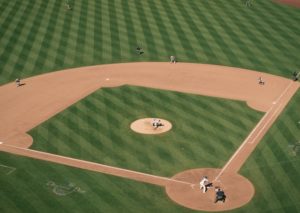If your kids are baseball obsessed, or just need to get some safe, extra practice close to home, this guide is for you. Creating a mini baseball field in your backyard requires a bit of effort but the results will be more than worth the labor. This guide will take you through the equipment requirements and the steps you have to take to get a cool, compact pitch in your own green space.
How Much Space Do You Need?
A baseball field, at least a professional one, is a huge thing. Therefore, unless you have acres to play with, you’re not going to be able to replicate the real size. There has to be at least enough room to pitch and to run between bases. So, the space does have to be quite significant. Every baseball field needs:
- A home plate
- Pitching mound
- Backstop
- Batter’s/Catcher’s Box
- 1st, 2nd, and 3rd base
- Foul territory
This all takes place in one handy diamond shape which projects beyond to provide space for all the key pointers. Usually, in professional baseball, it is 90-foot square. This is not really a realistic figure for a backyard, but it can fortunately be scaled down.
Try to Level the Garden
There is not much point in making your own baseball field if it is lumpy and bumpy. You will be putting players’ health and safety at risk and exposing them to a higher potential for injury during sprints and ball catching. Not every pitch is perfect, and certainly, sometimes there is a call for a rugged, outdoor experience when it comes to baseball. But for practice purposes and backyard playing, a smooth pitch is the optimum choice.
Before you get to leveling, you have to mow the lawn so that the grass is as short as possible. This will make it easier to spot all the hidden mounds. Raking down smaller bumps is easy enough to do by hand and will not require any special machinery. Where there are major protrusions or inversions, a roller may be necessary. You may have to regrow some of the grass at some of these stages, to maintain the health of the pitch. It would be worth getting some grass seed in stock just in case.
Get Your Bases Right
If your bases are in proportion, everything else will come together smoothly. They have to be evenly spaced apart for fairness’ sake and to emulate the real-life baseball pitch that players might go on to. When you triangulate the backstop and use a measuring tape to place the home plate too, getting the bases in the right place is much easier. After a player hits a ball, he or she has to run from base to base to gain a point. There has to be enough room to make it a bit challenging, while still protecting the excitement and enjoyment of the game.
The Pitching Mound
Pitching mounds are important because they exist to make the pitcher have an easier job. The pressure of throwing a no ball is enough to put some people off from ever putting themselves forward for the team, but it is easier to practice if you have the right mound. Find one that is easy to move, so you have increased flexibility in layout, and so that it can be stored away out of season (given that it is in your own backyard).
If it is your dream, or practical reasons are driving the vision, a backyard baseball field can be a fun thing to map out. Plan the dimensions carefully and make sure to use a measuring tape (of professional grade) to distinguish base lines and home plates.

